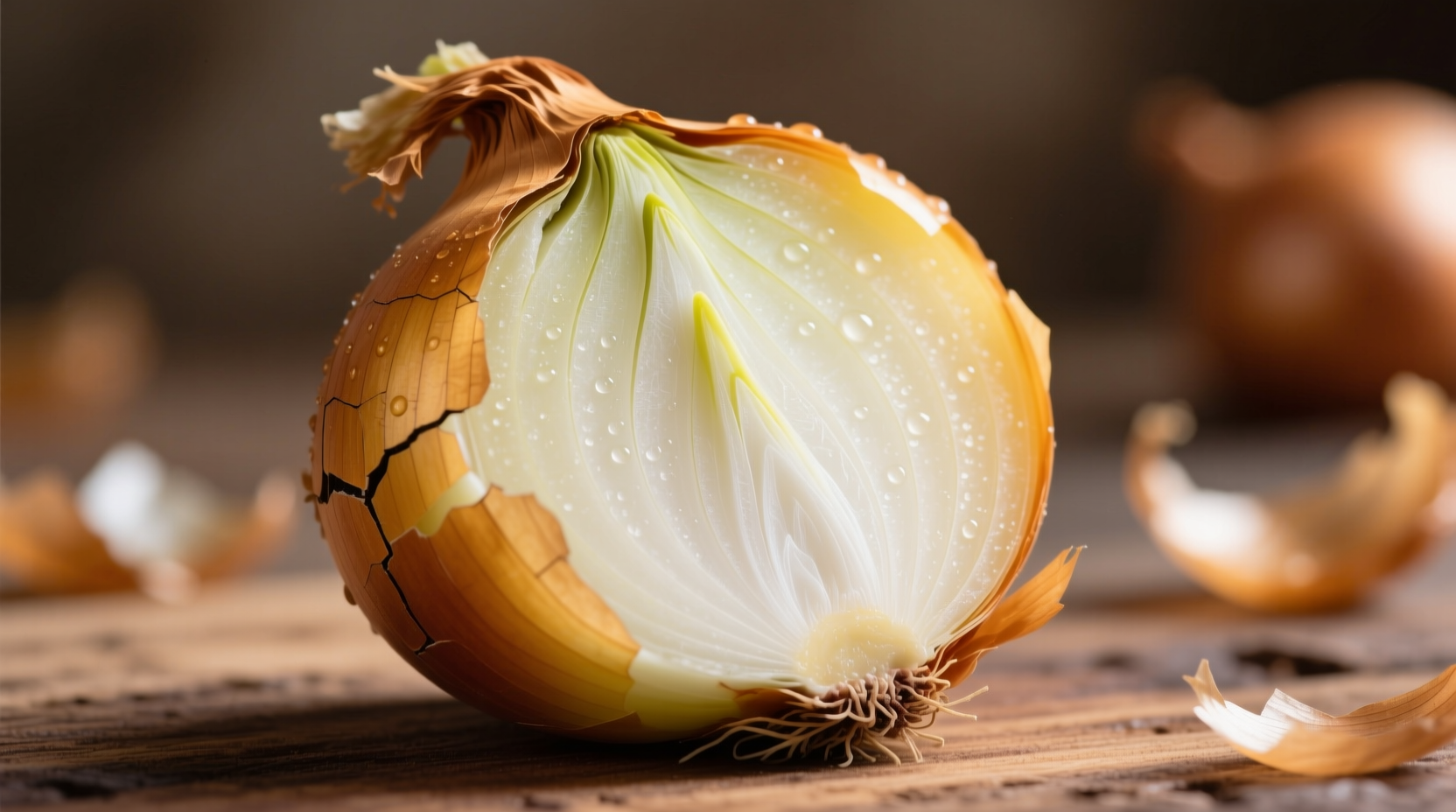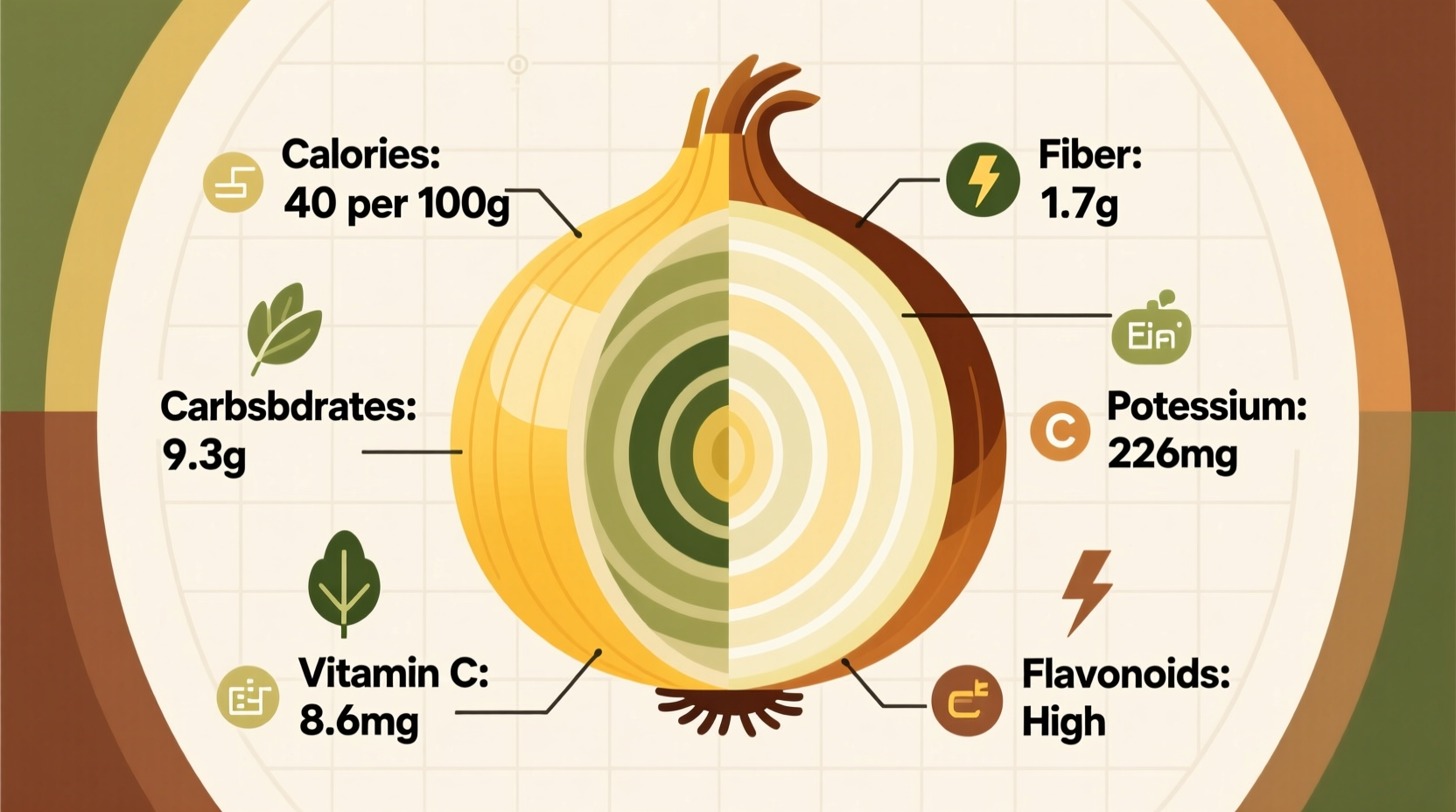One medium yellow onion (110g) contains just 44 calories, 10g of carbohydrates, 1.9g of fiber, and delivers 11% of your daily vitamin C needs. It's particularly rich in quercetin, a powerful antioxidant with anti-inflammatory properties, and provides notable amounts of vitamin B6, manganese, and potassium.
Discover exactly what makes yellow onions a nutritional powerhouse in your kitchen. Whether you're meal prepping, managing dietary needs, or simply curious about maximizing health benefits from everyday ingredients, understanding the precise nutritional composition of yellow onions can transform how you approach cooking and wellness.
What's Inside Your Yellow Onion: Complete Nutritional Breakdown
Yellow onions, the workhorse of most kitchens, offer more than just flavor—they deliver substantial nutritional value in every slice. According to the USDA FoodData Central database, a single medium yellow onion (approximately 110 grams) provides:
| Nutrient | Amount per Medium Onion (110g) | % Daily Value* |
|---|---|---|
| Calories | 44 | 2% |
| Total Carbohydrates | 10.3g | 4% |
| Dietary Fiber | 1.9g | 7% |
| Sugars | 5.0g | - |
| Protein | 1.2g | 2% |
| Vitamin C | 7.4mg | 11% |
| Vitamin B6 | 0.1mg | 6% |
| Folate | 19mcg | 5% |
| Potassium | 162mg | 5% |
| Manganese | 0.1mg | 6% |
*Percent Daily Values are based on a 2,000 calorie diet. Your daily values may be higher or lower depending on your calorie needs.
This nutritional profile makes yellow onions an excellent low-calorie addition to virtually any meal. The carbohydrate content primarily comes from natural sugars and beneficial fiber, rather than starches. The relatively high fiber content supports digestive health while helping to moderate blood sugar response when consumed as part of a balanced meal.
Powerhouse Compounds: Beyond Basic Vitamins and Minerals
What truly sets yellow onions apart from many other vegetables are their exceptional levels of bioactive compounds:
- Quercetin - Yellow onions contain significantly higher levels of this flavonoid antioxidant compared to white or red varieties. Research published in the Journal of Agricultural and Food Chemistry shows yellow onions can contain up to 1137mg of quercetin per kilogram, making them one of the richest dietary sources.
- Organosulfur compounds - Responsible for onions' characteristic smell and many of their health-promoting properties, including potential cardiovascular benefits.
- Anthocyanins - While present in smaller amounts than in red onions, yellow onions still contain these beneficial pigments.
These compounds work synergistically to provide anti-inflammatory, antioxidant, and potential cardiovascular benefits. A study from the American Journal of Clinical Nutrition found that regular onion consumption was associated with improved markers of cardiovascular health in adults.

Yellow vs. Red vs. White: Nutritional Differences That Matter
While all onion varieties share similar basic nutritional profiles, there are meaningful differences that might influence your cooking choices:
| Nutrient/Compound | Yellow Onion | Red Onion | White Onion |
|---|---|---|---|
| Quercetin content | Highest (up to 1137mg/kg) | Moderate (up to 756mg/kg) | Lowest (up to 300mg/kg) |
| Anthocyanins | Low | Highest | Negligible |
| Sulfur compounds | Highest | Moderate | Lowest |
| Flavor profile | Strongest, most pungent | Milder, slightly sweeter | Most delicate, mildest |
| Best culinary uses | Cooking, caramelizing, soups | Raw applications, salads | Mexican cuisine, salsas |
This comparison reveals why yellow onions dominate in professional kitchens—they offer the most robust flavor and highest concentration of beneficial compounds, particularly when cooked. The higher sulfur content contributes to their stronger flavor but also enhances their potential health benefits.
Maximizing Nutritional Benefits: Cooking Methods That Preserve Value
How you prepare yellow onions significantly impacts their nutritional profile. Understanding these context boundaries will help you make the most of their health benefits:
- Raw consumption preserves all heat-sensitive nutrients like vitamin C and maximizes quercetin bioavailability. However, raw onions can cause digestive discomfort for some individuals.
- Gentle sautéing (below 300°F/150°C) maintains most nutrients while making onions more digestible. A study in the Journal of Food Science found that light cooking actually increases the bioavailability of certain antioxidants.
- Caramelizing creates delicious flavor but reduces vitamin C content by approximately 25-30%. However, it enhances the formation of beneficial compounds through the Maillard reaction.
- Boiling causes the greatest nutrient loss, with water-soluble vitamins leaching into the cooking liquid. If boiling, consider using the cooking liquid in soups or sauces.
For maximum nutritional benefit, try slicing onions and letting them sit for 5-10 minutes before cooking. This allows beneficial compounds to fully develop. When possible, cook with the skin on (in broths or stocks) as many antioxidants concentrate near the outer layers, then remove the skin before serving.
Practical Applications: Incorporating Yellow Onions for Health
Understanding yellow onion nutrition isn't just academic—it directly translates to better meal planning and health outcomes. Here's how to apply this knowledge:
- For blood sugar management: Pair yellow onions with higher-carbohydrate foods. Their fiber and sulfur compounds may help moderate blood glucose response.
- For cardiovascular support: Include 1/2 cup of cooked yellow onions daily as part of a heart-healthy diet. Their quercetin content has been associated with improved blood pressure in multiple studies.
- For immune support: Add raw yellow onion to salads or salsas when you need an extra vitamin C boost during cold and flu season.
- For digestive health: Start with smaller portions if you're sensitive to onions, gradually increasing as your digestive system adapts to the fiber content.
Professional chefs like Antonio Rodriguez recommend keeping yellow onions in your meal rotation at least 4-5 times weekly to consistently benefit from their nutritional profile. "The versatility of yellow onions makes them perfect for building flavor foundations in soups, stews, and sauces while delivering substantial nutritional value," notes Rodriguez.
Frequently Asked Questions
How many calories are in a yellow onion?
A medium yellow onion (approximately 110g) contains about 44 calories. This makes yellow onions an excellent low-calorie ingredient that adds substantial flavor and nutritional value without significantly impacting your daily calorie intake.
Are yellow onions good for weight loss?
Yes, yellow onions can support weight loss efforts. With only 44 calories per medium onion and 1.9g of fiber, they add volume and flavor to meals without excess calories. The fiber content promotes satiety, helping you feel fuller longer. Their natural sweetness can also reduce the need for added sugars in recipes.
What's the difference between yellow and red onion nutrition?
Yellow onions contain significantly higher levels of quercetin (up to 1137mg/kg) compared to red onions (up to 756mg/kg), while red onions have higher anthocyanin content. Yellow onions also have more sulfur compounds, contributing to their stronger flavor and potential health benefits, particularly when cooked.
Do cooked onions retain their nutritional value?
Yes, but with some changes. Cooking reduces vitamin C content by about 25-30%, but actually increases the bioavailability of certain antioxidants like quercetin. Gentle cooking methods like sautéing preserve more nutrients than boiling. The sulfur compounds that provide many health benefits remain stable during cooking.











 浙公网安备
33010002000092号
浙公网安备
33010002000092号 浙B2-20120091-4
浙B2-20120091-4